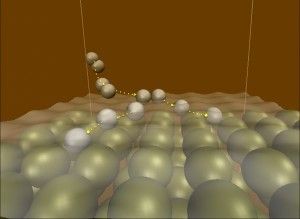ELECTRONIC FRICTION DOMINATES HYDROGEN HOT ATOM RELAXATION ON PD(100)
Despite electron-hole (e-h) pair excitations are an unquestioned efficient energy drain in the interaction of fast atoms and molecules with solids and surfaces, the relevance of this dissipation channel in gas-surface interactions that involve energies up to a few eV is frequently a matter of discussion.

On the one hand, low-energy e-h pair excitations have been detected as chemicurrents on Schottky diode devices during the chemisorption of atomic and molecular species on metals. The correlation found between chemicurrent intensities and adsorption energies is a strong indication that a large fraction of the energy dissipated in the adsorption processes is used to excite e-h pairs. On the other hand, this interpretation highly contrasts with most recent state-of-the-art theoretical calculations showing that the dissociative adsorption of precisely those molecules is reasonably well described within the electronically adiabatic approach, which neglects the coupling between electronic excitations and the nuclear motion. In view of this apparent contradiction, the question that emerges is clear: Is it possible to reconcile both unquestionable findings?.
In order to tackle this issue the gas-surface group at the CFM has developed a new methodology denoted AIMDEF that consists in ab-initio molecular dynamics simulations that incorporate on-the-fly the effect of e-h pair excitations. In their letter the authors show that, although e-h pair excitation may not be relevant on the molecule bond breaking timescale -what explains the success of the adiabatic approach-, it is an efficient dissipative channel in the subsequent relaxation of the resulting hot products that propagate until they reach thermal equilibrium with the surface. In the particular case of the dissociative adsorption of H2 on Pd(100), it is found that energy dissipation into e-h pairs occurs at a rate five times faster than dissipation into phonons. This finding provides a new perspective in the field of gas-surface dynamics as it contrasts with the commonly accepted assumption that considers energy dissipation into lattice vibration as the only relevant channel for hot atom thermalization.
The work has been done in collaboration with Prof. Kroes from the University of Leiden and Dr. Busnengo from the University of Rosario.



